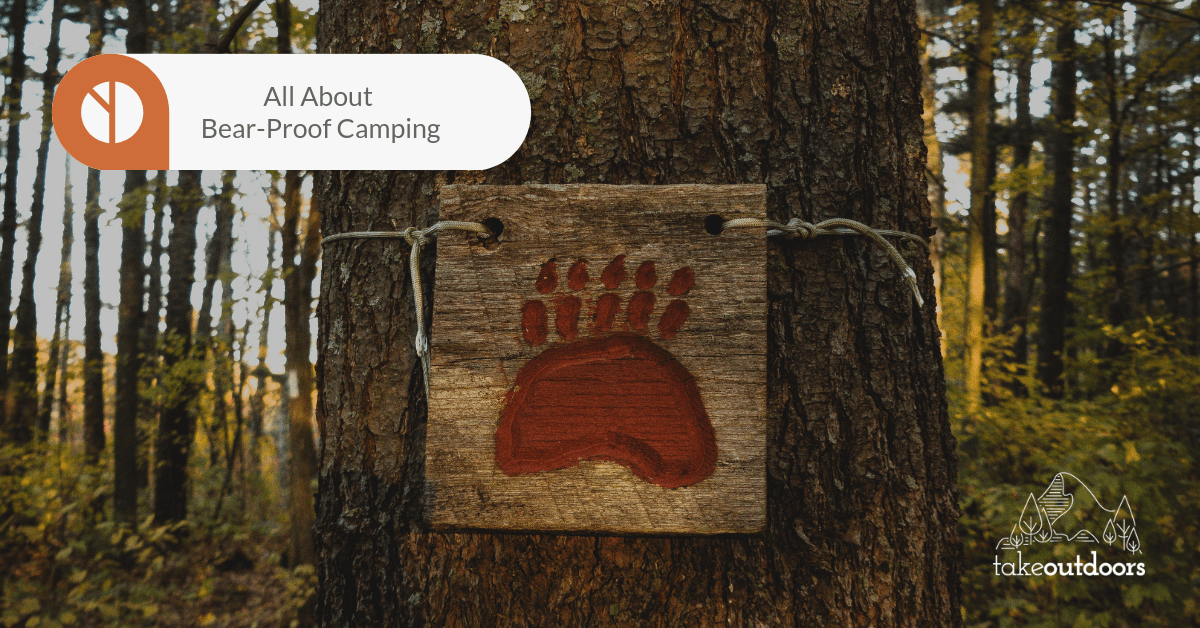We use affiliate links and may receive a small commission on purchases.
Read more about us.
In this article, we will tell you everything you need to know about bears, how to bear-proof your campsite and how to react when you encounter one. If you are heading to a bear county, read on further.
Attacks, Car Damage, Fear, Respect
The journey from largest omnivorous land animal in North America to snuggly nighttime buddy, is a matter that should confuse us all about North American Bears. While these creatures are some of the most beautiful on the planet we should never make the mistake of assuming they are as benign as the plush toy that sat on our pillow as a youngster.
Unfortunately, all too often, people make these mistakes with bears and get too close. Most times they are merely charged but every so often someone gets mauled to death by the apex predator. Make no mistakes about it, the bear is an apex predator.
All bears are not stone-cold killers, in fact, only about 3 people are mauled to death by bears each year. In 2005 we had our biggest year for the North American continent which saw a total of 6 deaths. Most of the time you can scare them off or take actions to deter them from bothering you, if you know how.
Do you?
Just because bears only kill three people a year doesn’t mean they are quiet for the rest of the year. Bear interaction and aggression are up as humans continue to close in on their territory. We are even seeing these creatures show up in backyards in places like New Jersey.
A mauling can leave you devastated, scarred and even disabled. While it may not result in death, it could get really bad.
Don’t forget about your car either. Bears do some severe damage to personal property each year. They can wreck your car in a hurry if you make the mistake of leaving food inside. They might smell out fragrance, perfume or leftover food and assume it might be tasty. Even with the windows up bears can rip and gnash at a car to see what’s inside.
Table of Contents
The Bear Breakdown
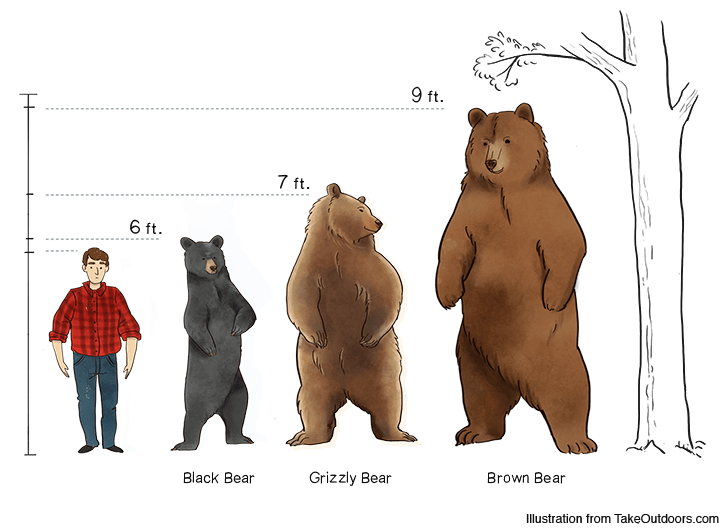
Black Bear
The least aggressive of the bear species in the continental US, black bears can still be a considerable threat in the right conditions. Black bears are also considerably smaller than brown bear. Those on the east coast will be the biggest of the species.
- Full grown males can range from 126 to 551 lbs
- Stand just over 6ft in most cases
- American black bear will everywhere bears should be
- Mostly found in Appalachians of the east, the rocky mountains and the west coast
Grizzly
The Grizzly Bear is a simply a brown bear but its one that lives on the interior of the continent. Brown bears keep their descriptive name when they live on the coasts of Alaska and Canada. The grizzly is the biggest and most aggressive bear you will find in the United States. They have golden or grey tips on their hair and this often gives them a grizzled look.
- Males: 400 to 790 lbs
- Females: 290 to 400 lbs
- Stand about 6 to 7ft tall
- Note: Can run up to 35 miles per hour!
- Mostly found in Idaho, Washington, Montana and Wyoming
Brown Bear
The brown bear is from the same species of bear as the grizzly. They are simply referred to as brown bear when they are found on the coastal regions.
- Range from 500 to 1100lbs
- Stand 9 ft tall on their back legs
- Live in Western Alaska, Canada and Washington
When are you in Danger?
If you are going to try to better manage bears and deter them on your hiking and camping trips, you are going to have to understand them. While bears don’t kill many people, they can hurt you and will certainly scare you to death if they “bluff charge” you. Or charge you to intimidate.
There is three unique circumstances that all campers should be aware of when regarding bears and their attitude and behavior. If you can get a grip on these three situations and how to deal with them you will be better prepared to avoid bear interactions.
Spring
When Bears have Cubs
Easily the most dangerous time to deal with bears is in the spring. You might be surprised to hear it, but no bear is more dangerous than a female. A female with cubs has two goals when she comes out of the den. She must feed the cubs and protect them at all costs.
While a female bear will likely not eat you, she will certainly maul you to the point of incapacitation where you could bleed out from injuries. Do not make the mistake of trying to film a mother bear and her cubs. Do not get close to take pictures of them either.
If you see a mother bear and her cubs, you have to understand that you are in the most danger of your entire trip. We will discuss how to react later in this guide.
Late Fall
When Bears are Preparing for Hibernation
Territory is a big deal when it comes to bears and the food they have access to. If a bear wanders into another bears territory for food, they can risk a serious fight. Remember, if a bear is wounded there are no hospitals to go to. Either they live, or they don’t.
Some bears have better territory than others. These areas have more access to water and food. For these bears, packing on the pounds for hibernation comes easy. There will be bears that struggle to eat enough for hibernation. They will have to work hard to get the food they need to survive. Some of these bears will not eat enough before hibernation. They will go into a highly aggressive hunger that makes them more dangerous than usual.
If you run into a bear during the early winter or late fall, depending on location, it could be one who is struggling to eat enough. They might think you could solve that problem.
Beware!
Anytime
When Food is Around
Food is always a weakness for bears. They have very powerful sense, their nose in particular is even more powerful than a dog’s. If you have food in your car or on your person, you must understand that bears in the area know about it. They can smell it. Its just a matter of how hungry they are and whether they want to take the risk that goes along with getting that food.
In our next section we will discuss more about food handling and storage.
What’s your Responsibility?
No matter how much time you spend in the woods it is not your home. When you enter into a bear’s territory you must be aware that you have responsibilities to care for that area, protect it and act in a way that will not create a conflict between you and the wildlife there.
Most outdoorsmen take this very seriously and I think that is why we see so few deaths from bears. If you are responsible and prepared you will likely only see bears from a distance. Never assume it’s the animals job to stay away from you.
Packing
- Bear Deterrents
- Food Storage
When packing for a trip in the outdoors you should always consider worst case scenarios first. If it all goes bad, what things will you need?
Regarding bears you are going to need some form or bear deterrent that you can access in a hurry, in the worst case.
Bear Deterrents that Work
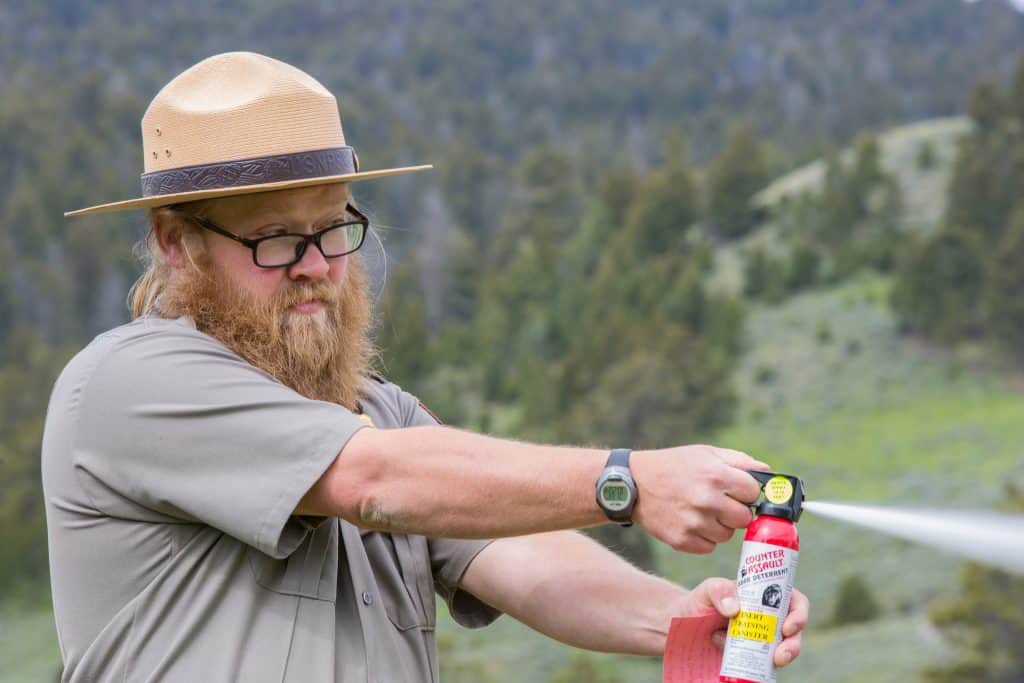
Bear Spray
Bear spray is the most common form of bear deterrent on the market. It is a highly potent pepper spray that will often deter bears from the discomfort. If you don’t run into a bear with cubs or who is starving and desperate they are pretty easy to convince.
You have to be pretty close to use the spray and you have to be very careful about wind direction. You don’t want to get mauled by a bear while suffering from pepper spray blowback in your face.

Air Horn
Bears will get scared and run away. They know that humans aren’t a good time. Even better is using a large mechanical horn to scare them away. These things work and if you have one in your bag you can use it long before the bear gets in spray range.
Strobe Light
Motion activated strobe lights can be set up at your campsite. This is pretty extreme, but it could work while you are sleeping. Bears can visit your tent in the night. This is especially true if you have food inside the tent with you.
Your Actions
Above all, your actions will be the best bear deterrent out there. If you choose your campsite properly, make yourself known and store your food properly you will do much more to prevent a bear altercation than anything you can buy at a store or online.
| Bear Deterrent | Effectiveness | Pros | Cons | Notes |
|---|---|---|---|---|
| <a href="https://takeoutdoors.com/camping-gear/tool/best-bear-spray-market/"Bear Spray | Highly Effective in up close encounters | Great for surprise encounters |
| |
| Air Horn | Effective from a distance | The best non-lethal deterrent for scarring from a distance |
| |
| Strobe Light | Great nighttime aid | Protects you all night |
| |
| Your Actions | Most effective | You can include all of the above and more | Only the things you forget | Nothing will protect you better than your overall preparation |
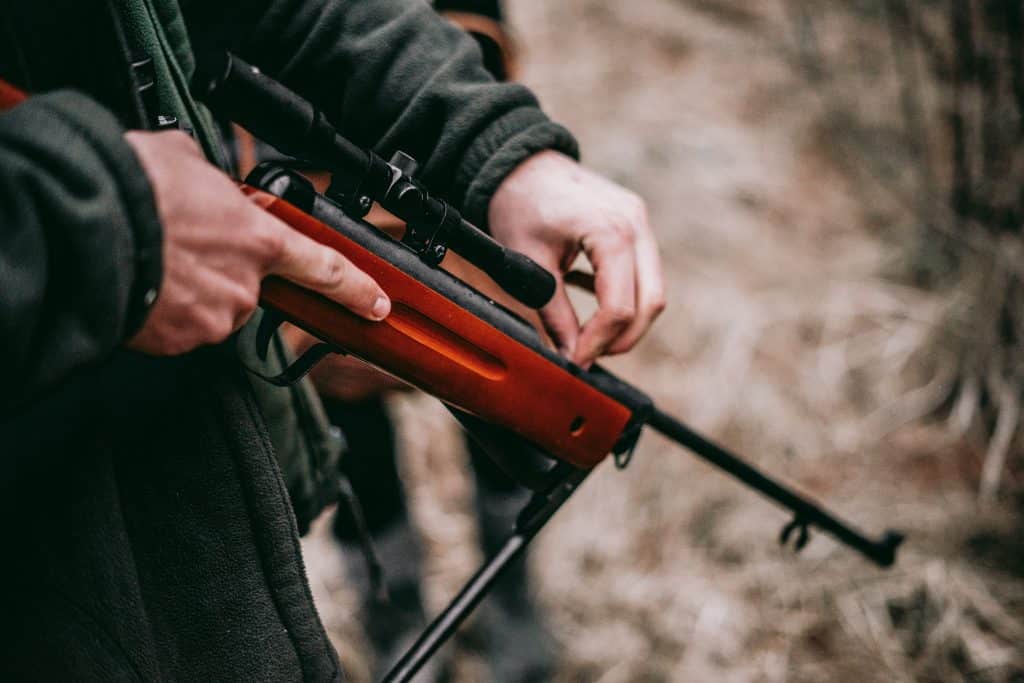
Guns and Bears
No matter what you read about guns and bears you have to understand that people who work in the most remote parts of the United States, where bears are prevalent, carry guns. Now, we will talk about types of guns and what will work against a bear but we have to first define “work” in your philosophy.
You see, there are two schools of thought when it comes to guns and bears. One is that firing a gun near or around a bear will make such a noise that it will scare the bear off, that is the extent of gun/bear interaction that some hikers and campers want. They do not want to kill a bear.
The other school of thought is that you are going into bear country, so you need to carry a gun that will kill a bear and if it gets to close, you do just that.
The choice is yours, but a gun brought into the woods should have the necessary ammo or caliber or both to stop a bear. Remember, you are not just responsible for yourself in the woods, but you could be responsible for others camping with you. In the worst-case scenario, you do not want to watch helplessly as someone you love is eaten alive.
In terms of handguns bears have been stopped with a well placed shot from a .22 rimfire. That said, I wouldn’t bet on anything less than a 9mm and I would bring a couple magazines. The best gun for stopping anything in the North American woods is the 12 gauge shotgun. A powerful slug is going to stop a bear.
If a rifle is more your thing look at any of the medium to large bore rifle firing 30-06 or any .33+ caliber for that matter.
What most articles don’t tell you about carrying guns in National Parks is that many states don’t allow you to carry loaded firearm in their parks. This means you better plan ahead and know your restrictions. Most parks do honor CCW or Concealed Carry Weapons permits.
Food Storage: The Key to Bear Safety
If you ignore the rules of backwoods camping in bear country, you do so at your own peril. A bear’s sense of smell is the best among all terrestrial animals. They have the ability to smell a food source from 18 miles away!
You think they cannot smell that chili mac mountain house that you had for dinner?
There are things to aid you in your attempts at hiding your food from bears:
Cook and Eat away from your Campsite
The first and most important is cooking and eating away from your campsite. This can seem like a fundamental problem for many campers because they want to eat around their fire and in their camp. Keep this layout in mind.
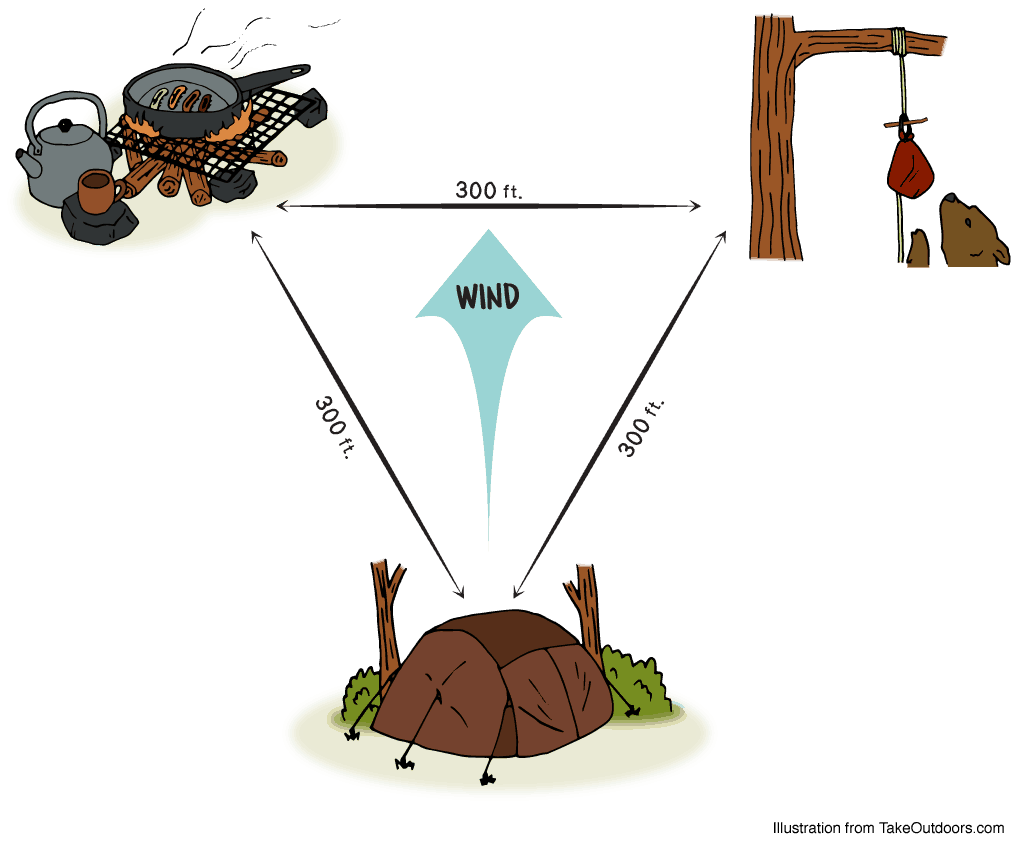
There are some things that you can do to make this a much more enjoyable experience. You need to first understand your path back to camp. Carry headlamps and make sure you can get back there no matter what happens.
Choose a magnificent view or scenic feature to enjoy while you eat. It may not be camp, but it will be a beautiful place to take in a meal.
Store your Food the Bear-proof Way
Now you may not eat all of your food on that first night, so you have to do something with the rest. You are to hang the food in a location that is 100 yards downwind from your camp. The food should be hung on a branch at least 12 feet in the air. This is a method called “bear bagging.” Be sure you keep paracord in your pack and a strong bag that can be used for this.
There is another method of bear bagging called PCT style.
Storing your food in a bear canister is the best method for trapping that smell and assuring the bears have a harder time finding out what you are holding onto. These bear canisters can be purchased for just under $100 to nearly $300. They make a tremendous difference and can be very effective.
Change your Clothes after Cooking and Eating
A step that many campers often forget is to change clothes and store clothes that were used during cooking and eating. Depending on what you are eating the smoke and the smell from your clothes can be just as alluring to bears as the food itself. If you smell like a big steak, that is not a great message to send to the bears.
When you return to your camp you should be as free of any elements of your meal as possible. That might even mean a dip in the creek that you ate by.
Dispose your food properly
The final piece of the food storage puzzle is what to do with the food you don’t eat. There are serious implications with this one. You see, bears are creatures of habit and will return to a site if there was food there before. You do not want to leave food at campsite, in the campfire or anything like that. Even if you don’t return to that campsite, someone will.
Your food waste should be packed out if you are near the end of your trip. You can hang food waste and wrappers with your other food. If it is all food scraps and organic materials you can leave the food where you prepared it. Just don’t bring any of it back to camp.
Your best bet is to eat all your food and wash your containers out at the cook site. Leave the food scraps there and only return with packages. These can be hung just like the rest of your food. So bring an extra bag or cannister if you plan on operating this way.
On the Trail
Even if you are not camping or haven’t set up camp there are still responsibilities that you must take seriously along your journey.
Bears are Not Photo Opportunities
You can see all the bears you want on television, in HD or whatever. When you see that first bear in real life, amongst the backdrop of the wilderness it will take your breath away. They are a massive beast and when you see a big male or a female with some cubs it’s a special situation.
Like all special situations in our lives today you will likely reach for your phone to take pictures. Despite the size and danger of these massive apex predators, people still think its ok to get close and take pictures or even selfies with bears.
Most experiences in the wild are best left there and pictures hardly do the experience justice. So, take my advice, keep these memories to yourself.
Tracking
Most people who enter the woods and the national forests don’t consider themselves a burden or out of place. This next responsibility is one that will make you think differently. Where you decide to hike, or camp is not the bears problem. Its yours. Therefore, you need to be able to tell where bears frequent, live and where they do not.
Learning the very basics of tracking and habitat can make all the difference. Lets look at 4 dead giveaways that there are bears in an area.
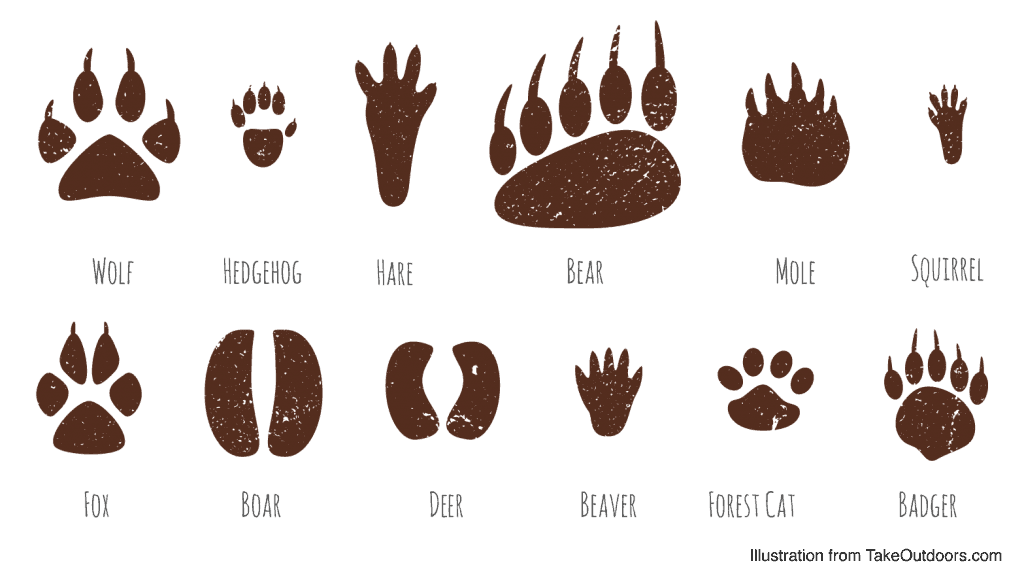

Bear Tracks
One of the best methods of measuring bear activity is looking at the tracks that are around an area. If you are moving off a defined path or setting up a campsite, the presence of bear tracks in an area is always a great tell.
Now, tracks can be tough to place on a timeline. They could be old tracks or new ones and it can be hard for the average person to tell the difference. For the beginner, just look at the volume. Choose quantity over quality. If there are lots of bear tracks in an area move to another spot or get off that trail.
Scat
Bear scat or droppings in an area is another wonderful way to tell that bears are in an area. If you see lots of bear scat you need to consider a new campsite as well. This means bears are close and they are eating in this area. It could be a very valuable place.
Imagine that you woke up and found someone in your kitchen or bathroom. That is what its like for a bear. This is their territory and you are an intruder.
Food Sources
Bears are omnivorous which means they eat fruits and nuts as well as meats. It might seem idea to set up camp near a thicket of wild raspberries or blackberries. This is not always a sure sign of bear activity but if you are near similar food sources and you see other signs, like tracks and scat, you need to move on.
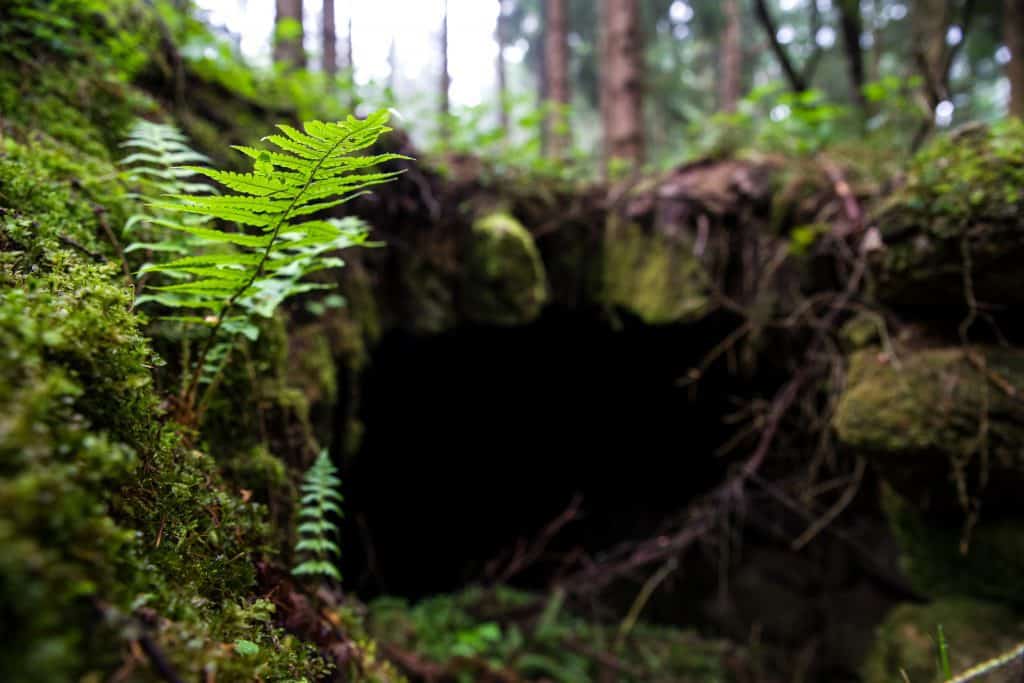

Caves and Dens
Bears live in caves and dens. These areas are pretty obvious to most because they house big creatures. Dens are often dug out from the sides of hills or mountains. They leave exposed roots and make a decent hole.
The area around bear caves may show all of the above signs mentioned. They also may show no signs. This is very important to remember. Don’t camp in or around caves, this can be very risky without bears around. Move far from bear dens and other shelters to be safe. Remember territory.
Setting up Camp
We have discussed our preparation before camp and even food storage at camp. Now its time to look at the type of camping you are doing and how that can relate to the probability of a bear interaction.
Types of Camping vs Bear Risk
Car Camping
This is a very popular mode of camping and while we are not talking about camping in the car or on the truck, which has become increasingly popular, you are always very close to your car. At these campsites you are driving a vehicle right up to a fire ring and an area to setup your tent. This method is great for families and also for beginning campers.
These campsites are well manicured and things like wildlife and even poison ivy are often managed. At these car camping sites, you are less likely to see bears because there are people whose job it is to keep them away and remove them if they show up.
Park and Hike at a Campsite
Some campsites are well known but require a bit of a hike to get to. These areas may even have fire lays or rings at various locations due to consistent camping. Some of the best examples here are wildlife management areas that are state managed.
These areas can be great fun. Bears will not be managed at many of these sites and you will be at an increased risk for bear interaction here. There will likely not be game wardens or other wildlife managing personal in the area to help you either. Keep this in mind.
Backwoods Camping
When you are camping in the backwoods you are basically on your own. In some parks you will fill out a small piece of paper to give you a little traceability but beyond that its all on you. You will be left to find your own campsite. You will be responsible for not camping in an area that could flood, where limbs might fall and kill you or where wildlife, like bears, are prevalent.
You should create very clear processes and get some car camping under your belt before you take on backwoods camping. Here there is very little room for error on all fronts. Its up to you to keep the bears away.
A Bear in Camp or Bear Interaction
There is a lot of information about bears aggressive or defensive postures. Black bears and Grizzly bears have a tendency to act differently in the situations we are going to mention. The very first step in a bear interaction is recognize what is going on and make yourself known.
From a distance you can often just avoid the bear and give it its space. That will work out in most cases. Obviously make an attempt to walk in the opposite direction of the bear.
Take Action
In some situations, you might walk up on a bear that is on your trail or in your camp. They could be there for a number of reasons. You will want to use this moment to assess what you are dealing with. Are there cubs around? Is it a black or brown bear?
An appeasing voice and slow movement away from the bear, while facing it, will often cause most bears to run off just out of the sheer fact that they know humans can be a problem. These bears might be wandering in the search of food and changing course is no sweat of their back.
In this situation you should still ready your bears spray. You can never be sure how these situations will play out. Grizzly bears are more likely to engage you in these type situations than black bears, unless they have cubs.
Defending a Carcass
If you happen upon a bear with a carcass you must understand that bear is willing to take tremendous risks for that food. Your best bet is to move away the same way you came in a calm fashion similar to above.
Keep your bear spray at the ready and if the bear leaves the carcass to approach you spray them immediately and continue moving away.
Mother with Cubs
This is the true ‘play dead scenario’ when it comes to bear contact. If a mother rushes you, bear spray, of course. If she carries on you need to curl up with your stomach towards the ground, tuck your knees and cover your head and neck as best as possible. Ideally you will be mauled until the mother bear believes you are no longer a threat.
Stay still till the mother bear is out of the area. Be very sure about this. If you are not you could get attacked twice.
If Mama starts to eat you the time has come to fight back. You need to ready any weapon you have on hand to deal with mother bear. It’s a sad situation but you have to do everything you can to survive.
Aggressive Bear
There are times when a bear will come to you. This might be in a non-defensive, exploratory manner or in an aggressive manner. With these types of bears you must remain firm. Eye contact is important and a strong voice. Move out of the way of the animal, if you can and it might just pass by. You could be in its way.
If the bear follows you this means you are being tested. It is looking to see if you are a threat or if it can eat you or something you have. In this instance it is very important that you prepare to fight. Use your deterrents and a big posture. Yell at the bear and get those in your party to do the same.
In most cases this will scare the bear away. If you find yourself in combat with the bear you need to attack with any weapons, firearms or sticks that you have. Attack the eyes, nose and face of the animal.
First aid following a Bear Attack
There are many instances where you will benefit from having a first aid kit. You would be foolish to enter the woods without one. After a bear attack you will likely be contending with a few serious injuries. In many instances people who are attacked by bears suffer only a few scrapes and bruises.
Its not always a horror show.
Still, you will want to be able to deal with a few things.
- Punctures
- Bruises
- Fractures
- Cuts
Your best bet will be to get to a doctor as soon as possible but that might be out of the question. Till then you will need to do your best to clean, medicate and cover open wounds. You might also have to splint broken bones.
Here is a list of IFAK items that you should pack for just this situation.
- Israeli Bandages
- Tourniquet
- Quick Clot
- Antispetic for cleaning wounds
- Antibiotic Ointment
- Ace Bandages
- Good Quality Bandages
- Rolled Gauze
- Gauze Pads
- Nitrile Gloves
- Tweezers
- Splint (or the required skills to create a splint)
Report Activity
The bear that attacked you could attack other people. You will not know the motivations or the reasoning behind the attack, unless you spooked a mother and its cubs. If you can report the attack or have someone report it, it could save someone else from going through a similar or worse situation.
Of course, get help first but if you can report the activity it will benefit those in the surrounding areas.
This should be your final task in dealing with a bear.
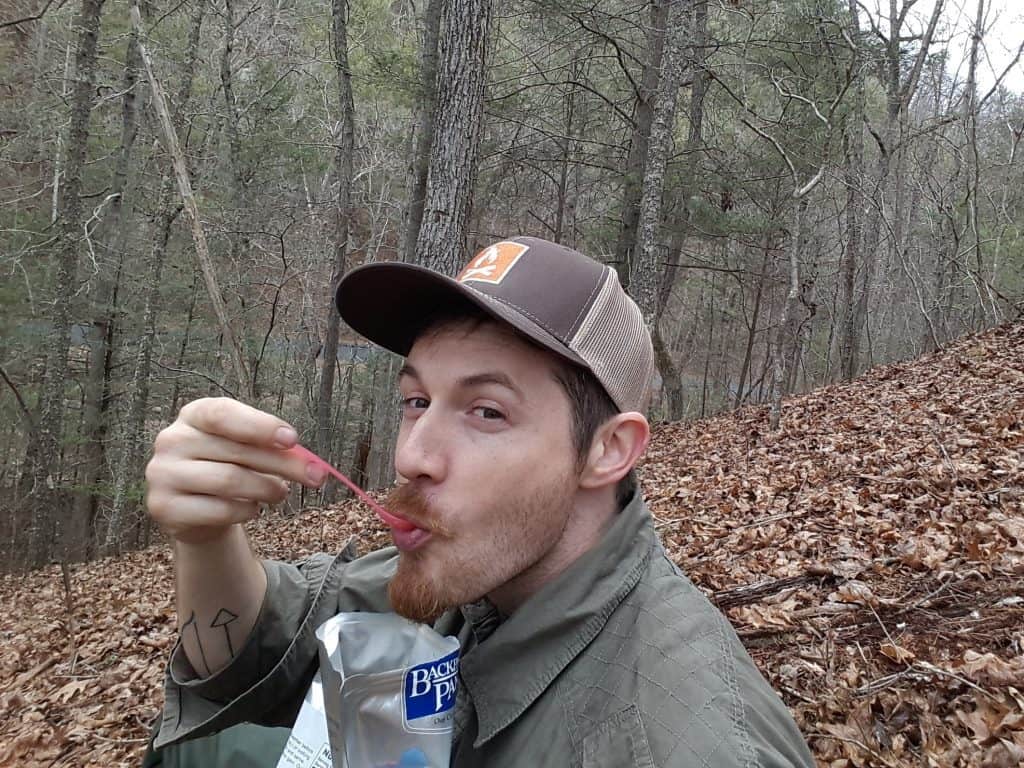

James is the author of Come Unity; Community and the host of the I AM Liberty Show. He is also a freelance writer writing for survival and outdoor publications and blogs jwwrites.com

